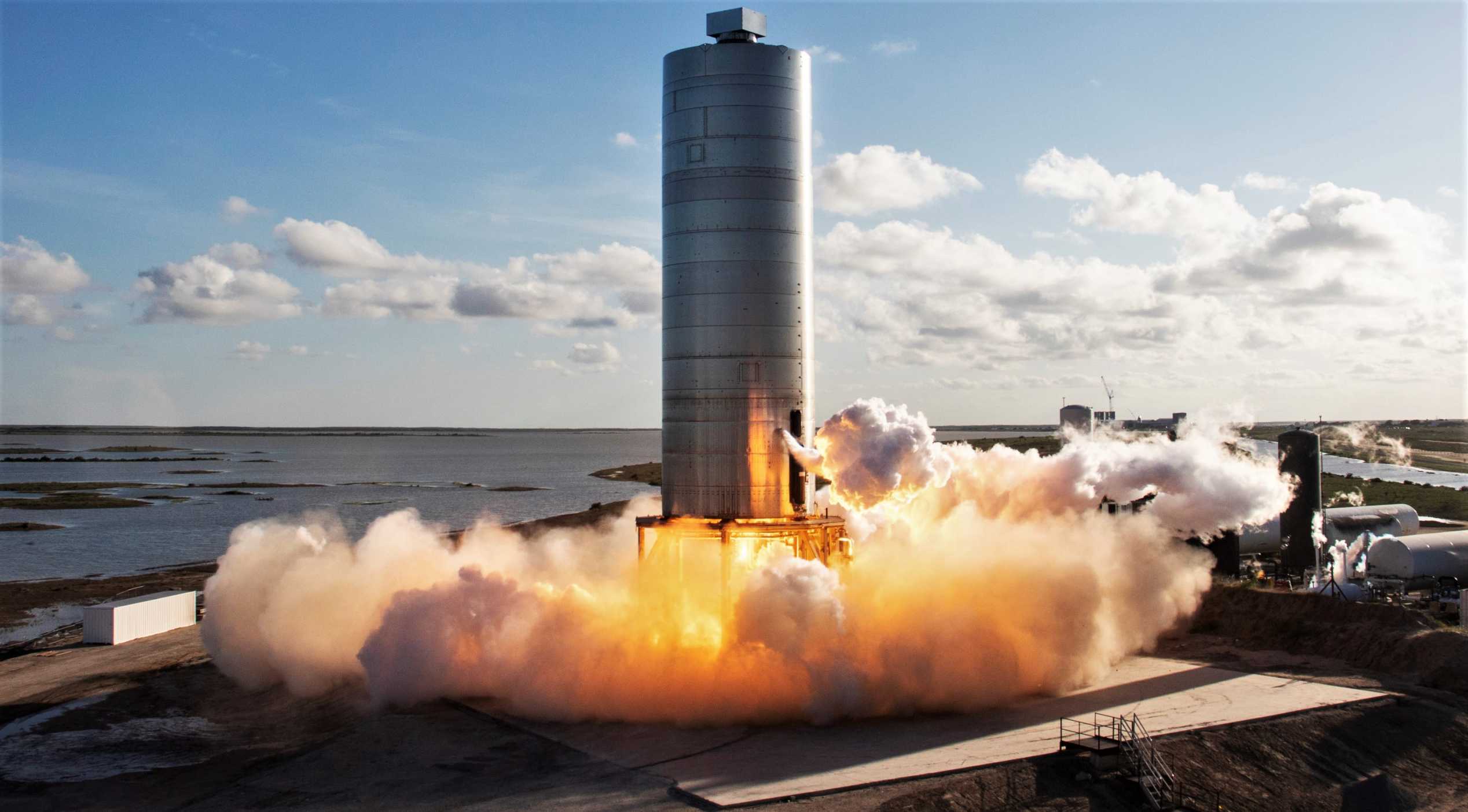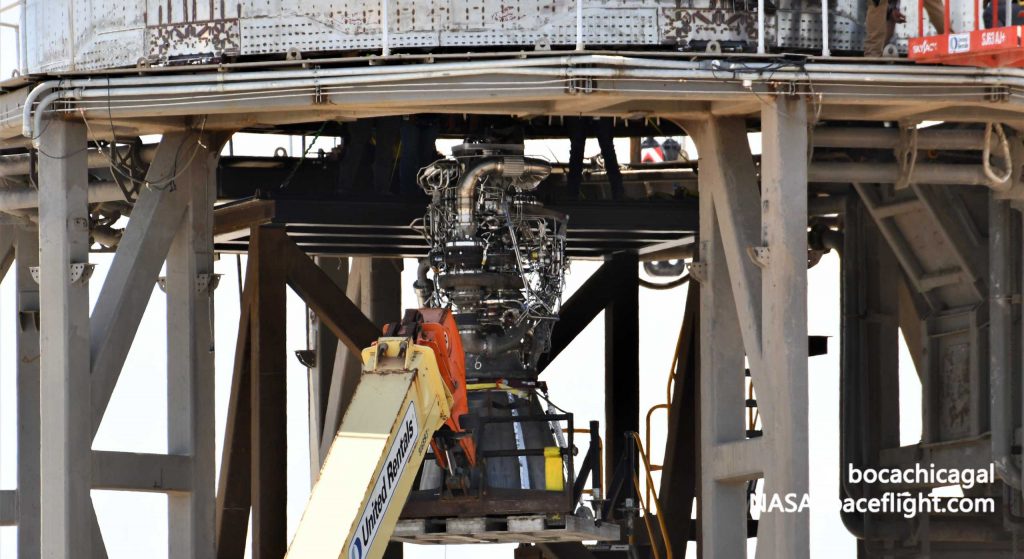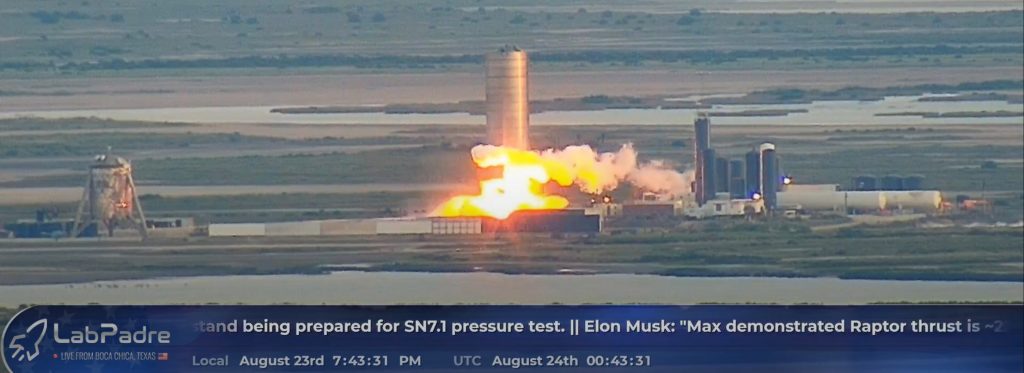

News
SpaceX’s second Starship hop imminent after Raptor static fire test
SpaceX has successfully fired up a new Starship prototype’s Raptor engine, putting the company on track for its second Starship hop test as soon as this week.
The milestone comes not long after SpaceX Starship serial number 6 (SN6) completed its first cryogenic proof, a pressure test with liquid nitrogen (LN2) used to safely verify the structural integrity of tanks (and rockets, in particular). Measuring 9m (30 ft) wide and some 30m (~100 ft) tall, SpaceX rolled Starship SN6 from its Boca Chica, Texas factory to a nearby test and launch facility on August 11th and wrapped up its first acceptance test on August 16th.
Now, just seven days after its cryo proof, SpaceX has installed a new Raptor engine (SN29), prepared SN6 for a much riskier round of tests, and completed a static fire with said engine, leaving just one major step between the Starship and its hop debut. Of course, the process still had its fair share of hiccups.
SpaceX’s first SN6 static fire test window – published by Cameron County in the form of road closure notices – was set for 8 am to 8 pm CDT (UTC-5), August 23rd a few days after the Starship’s cryo proof. The first test attempt began around 9:30 am but was aborted soon after as SpaceX employees returned to the launch pad to (presumably) troubleshoot. The second attempt began around 2:30 pm, leaving a little less than half the test window available.
Attempt #2 very nearly managed to extract a static fire, aborting possibly a second or less before Raptor ignition around 3:41 pm. Once again, SpaceX teams returned to the pad after Starship was detanked and safed, briefly inspecting the general location of the rocket’s Raptor engine before once again clearing the pad around 6:30 pm. At long last, Starship SN6 began a smooth and fast flow that culminated in the ignition of Raptor SN29 around 7:45 pm, just 15 minutes before the end of SpaceX’s test window.


As with all SpaceX static fires, engineers must still analyze the data produced – and possibly inspect pad or rocket hardware – to verify vehicle health before proceeding into launch operations. Unlike all other SpaceX static fires, the company doesn’t announce the results of those tests – nor the solidified launch window – during prototype development programs. In the context of iterative aerospace development, while there may be such a thing as a “good” or “bad” test, all tests – as long as they’re performed safely and produce a large quantity of usable data – are essentially successful.
As such, it’s likely for the best that SpaceX doesn’t put the public focus on the “success” of any given test. Still, it means that unofficial educated guesses are typically the only way to determine the results of any given test and how those results impact the next steps. For SN6, the very broad-strokes conclusions one can draw from unofficial livestreams suggest that the Starship’s first Raptor static fire was a success. Assuming that the unknown cause(s) of the day’s two prior aborts were minor and easily rectified, SpaceX is likely exactly on schedule for Starship SN6’s first hop attempt.
SN6’s first flight is expected to be an almost identical copy of Starship SN5’s highly successful August 4th debut, following the same 150m (~500 ft) parabolic trajectory. Filed before SN6’s August 23rd static fire, SpaceX has penciled in Friday, August 28th for Starship SN6’s own hop debut. Thanks to the fact that SpaceX was able to complete both SN6’s cryo proof and static fire on the first day of their respective test windows, August 28th is likely well within reach. Stay tuned for updates as Starship SN6’s hop debut schedule solidifies.
Check out Teslarati’s Marketplace! We offer Tesla accessories, including for the Tesla Cybertruck and Tesla Model 3.
News
Tesla begins Robotaxi certification push in Arizona: report
Tesla seems serious about expanding its Robotaxi service to several states in the coming months.

Tesla has initiated discussions with Arizona transportation regulators to certify its driverless Robotaxi service in the state, as per a recent report from Bloomberg News. The move follows Tesla’s launch of its Robotaxi pilot program in Austin, Texas, as well as CEO Elon Musk’s recent comments about the service’s expansion in the Bay Area.
The Arizona Department of Transportation confirmed to Bloomberg that Tesla has reached out to begin the certification process for autonomous ride-sharing operations in the state. While details remain limited, the outreach suggests that Tesla is serious about expanding its driverless Robotaxi service to several territories in the coming months.
The Arizona development comes as Tesla prepares to expand its service area in Austin this weekend, as per CEO Elon Musk in a post on X. Musk also stated that Tesla is targeting the San Francisco Bay Area as its next major market, with a potential launch “in a month or two,” pending regulatory approvals.
Tesla first launched its autonomous ride-hailing program on June 22 in Austin with a small fleet of Model Y vehicles, accompanied by a Tesla employee in the passenger seat to monitor safety. While still classified as a test, Musk has said the program will expand to about 1,000 vehicles in the coming months. Tesla will later upgrade its Robotaxi fleet with the Cyercab, a two-seater that is designed without a steering wheel.
Sightings of Cybercab castings around the Giga Texas complex suggests that Tesla may be ramping the initial trial production of the self-driving two-seater. Tesla, for its part, has noted in the past that volume production of the Cybercab is expected to start sometime next year.
In California, Tesla has already applied for a transportation charter-party carrier permit from the state’s Public Utilities Commission. The company is reportedly taking a phased approach to operating in California, with the Robotaxi service starting with pre-arranged rides for employees in vehicles with safety drivers.
News
Tesla sets November 6 date for 2025 Annual Shareholder Meeting
The automaker announced the date on Thursday in a Form 8-K.

Tesla has scheduled its 2025 annual shareholder meeting for November 6, addressing investor concerns that the company was nearing a legal deadline to hold the event.
The automaker announced the date on Thursday in a Form 8-K submitted to the United States Securities and Exchange Commission (SEC). The company also listed a new proposal submission deadline of July 31 for items to be included in the proxy statement.
Tesla’s announcement followed calls from a group of 27 shareholders, including the leaders of large public pension funds, which urged Tesla’s board to formally set the meeting date, as noted in a report from The Wall Street Journal.
The group noted that under Texas law, where Tesla is now incorporated, companies must hold annual meetings within 13 months of the last one if requested by shareholders. Tesla’s previous annual shareholder meeting was held on June 13, 2024, which placed the July 13 deadline in focus.
Tesla originally stated in its 2024 annual report that it would file its proxy statement by the end of April. However, an amended filing on April 30 indicated that the Board of Directors had not yet finalized a meeting date, at least at the time.
The April filing also confirmed that Tesla’s board had formed a special committee to evaluate certain matters related to CEO Elon Musk’s compensation plan. Musk’s CEO performance award remains at the center of a lengthy legal dispute in Delaware, Tesla’s former state of incorporation.
Due to the aftermath of Musk’s legal dispute about his compensation plan in Delaware, he has not been paid for his work at Tesla for several years. Musk, for his part, has noted that he is more concerned about his voting stake in Tesla than his actual salary.
At last year’s annual meeting, TSLA shareholders voted to reapprove Elon Musk’s compensation plan and ratified Tesla’s decision to relocate its legal domicile from Delaware to Texas.
Elon Musk
Grok coming to Tesla vehicles next week “at the latest:” Elon Musk
Grok’s rollout to Tesla vehicles is expected to begin next week at the latest.

Elon Musk announced on Thursday that Grok, the large language model developed by his startup xAI, will soon be available in Tesla vehicles. Grok’s rollout to Tesla vehicles is expected to begin next week at the latest, further deepening the ties between the two Elon Musk-led companies.
Tesla–xAI synergy
Musk confirmed the news on X shortly after livestreaming the release of Grok 4, xAI’s latest large language model. “Grok is coming to Tesla vehicles very soon. Next week at the latest,” Musk wrote in a post on social media platform X.
During the livestream, Musk and several members of the xAI team highlighted several upgrades to Grok 4’s voice capabilities and performance metrics, positioning the LLM as competitive with top-tier models from OpenAI and Google.
The in-vehicle integration of Grok marks a new chapter in Tesla’s AI development. While Tesla has long relied on in-house systems for autonomous driving and energy optimization, Grok’s integration would introduce conversational AI directly into its vehicles’ user experience. This integration could potentially improve customer interaction inside Tesla vehicles.
xAI and Tesla’s collaborative footprint
Grok’s upcoming rollout to Tesla vehicles adds to a growing business relationship between Tesla and xAI. Earlier this year, Tesla disclosed that it generated $198.3 million in revenue from commercial, consulting, and support agreements with xAI, as noted in a report from Bloomberg News. A large portion of that amount, however, came from the sale of Megapack energy storage systems to the artificial intelligence startup.
In July 2023, Musk polled X users about whether Tesla should invest $5 billion in xAI. While no formal investment has been made so far, 68% of poll participants voted yes, and Musk has since stated that the idea would be discussed with Tesla’s board.
-

 Elon Musk1 week ago
Elon Musk1 week agoTesla investors will be shocked by Jim Cramer’s latest assessment
-

 Elon Musk3 days ago
Elon Musk3 days agoElon Musk confirms Grok 4 launch on July 9 with livestream event
-

 Elon Musk18 hours ago
Elon Musk18 hours agoxAI launches Grok 4 with new $300/month SuperGrok Heavy subscription
-

 News7 days ago
News7 days agoTesla Model 3 ranks as the safest new car in Europe for 2025, per Euro NCAP tests
-

 Elon Musk2 weeks ago
Elon Musk2 weeks agoA Tesla just delivered itself to a customer autonomously, Elon Musk confirms
-

 Elon Musk1 week ago
Elon Musk1 week agoxAI’s Memphis data center receives air permit despite community criticism
-

 Elon Musk2 weeks ago
Elon Musk2 weeks agoTesla’s Omead Afshar, known as Elon Musk’s right-hand man, leaves company: reports
-

 News2 weeks ago
News2 weeks agoXiaomi CEO congratulates Tesla on first FSD delivery: “We have to continue learning!”

















